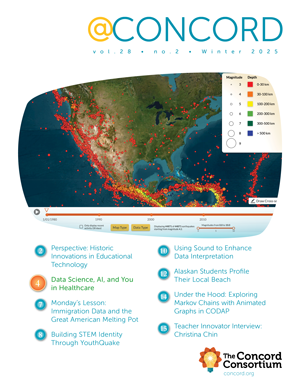The Deeply Digital Texts Initiative, Inquiry in the Digital Classroom, Teaching Evolution to Fourth Graders, and more in Fall @Concord
The Deeply Digital Texts Initiative
The latest educational trend is to jettison textbooks in a quick switch to alternative technology. A prep school in Massachusetts has proudly announced the dismantling of their entire school library in favor of digital books. Parents are searching for alternatives to buying college texts, the cost of which often tops $1,000 per year. Amazon is hoping to capture part of the $5.5 billion textbook market with their Kindle reader.
Perspective: Teaching Beyond the PDF
The call for digital texts is loud and clear. Fueled by perceived cost savings and tantalizing examples of available e-readers, nonprofit and commerical organizations alike have been touting various descriptions of such textbooks and have begun to produce examples. Amazon and Sony’s e-readers have jockeyed for starting position for years already, and Barnes and Noble has just sprung out of the gate to join them. Governor Arnold Schwarzenegger has launched a campaign to bring digital textbooks to many California schools.
Monday's Lesson: Inquiry in the Digital Classroom
Inquiry is essential in learning and doing science. The nature of science itself is an inquiry-based enterprise, and research has shown that students learn science best by doing science.
Tuesday's Lesson: Teaching Evolution to Fourth Graders
The year 2009 marks the 150th anniversary of the publication of Charles Darwin’s The Origin of Species in which he famously described for the first time his theory of evolution by natural selection. Perhaps to mark the occasion, the National Science Foundation recently awarded the Concord Consortium a grant to design curriculum for introducing this difficult concept to elementary students. Try our three Evolution Readiness computer-based activities with your fourth graders and watch plants evolve.
Wednesday's Lesson: Visualizing Energy
Teaching students even the most straightforward ideas about energy can be fraught with misconceptions. Conceptualizing an abstract entity that often cannot be seen or felt presents a host of complications, and requires new approaches to teaching. One of the best ways to help students understand such a multi-faceted concept is by using a variety of tools, representations, and strategies. In our Cumulative Learning using Embedded Assessment Results (CLEAR) project with the University of California, Berkeley, we are exploring how different representations reveal student thinking about energy.
Thursday's Lesson: The Greenhouse Effect
Students need to understand the greenhouse effect to grasp the causes of global warming. Studying the greenhouse effect covers many important science topics—light, energy, molecules, heat, and temperature, to start—and supports system thinking. But understanding the greenhouse effect is challenging.
Friday's Lesson: How Transistors Work
Although technology and engineering courses at the high school and college level now include microelectronics, teaching this subject is no small matter! The pedagogical challenge arises because microelectronics is a synthesis of many high-level fields, including solid-state physics, quantum mechanics, thermodynamics, statistical mechanics, electronics, and signal processing. Most curriculum materials employ mathematical formulation and didactic instructions. While this approach may work for advanced college students, the learning curve is far too steep for most high school and community college students.


